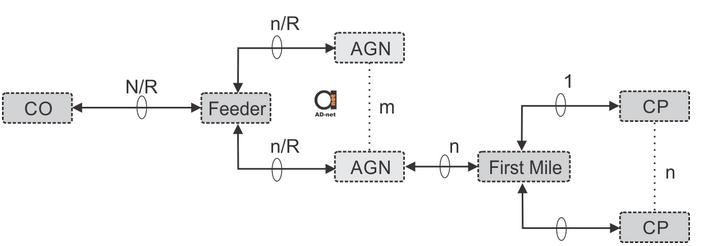The costs involved in the outside plant of FTTx networks are determining the validity of any access technology. Installation and materials have highly big cost per subscriber. By assuming average lengths most costs of the outside plant can be simplified. Unfortunately, design rules and dimensions will not be determined accurately enough.
The Feeder contributions should be included in scenario when many customers are connected to the concentrator, but many concentrators are connected to Central Office.

Figure 1. Basic outline of a Techno-Economic Access Network model.
As seen from Figure 1, in the Techno-Economic Access Network model the Network Node at the Central Office is connected to a Feeder, while Feeder network is connecting aggregation nodes, which are connected to Network Termination at the Customer Premises. Model should support different types of connection (including wireless and copper) and topologies (rings, trees, and meshed networks). Some new technologies, like switching, might be introduced for the economic evaluation with associated consequences for transmissional requirements. Complexity of the network is making powering dependent on it and makes it significant expense factor. The cost model for one CO is based on total amount of subscribers through some amount of AGNs. Design parameters can be seen from Table 1.
Table 1. Network model dimensions
| N | Number of subscribers per CO |
| M | Number of concentrators per CO |
| n | Number of subscribers per AGN |
| R | Multiplexing ratio of the concentrators |
Values in this table are calculated from the assumption that customers are connected to AGNs by single wire or wireless. Design parameter n is calculated from n = N/m. AGNs are using n/R wires to connect to the Central Office.


